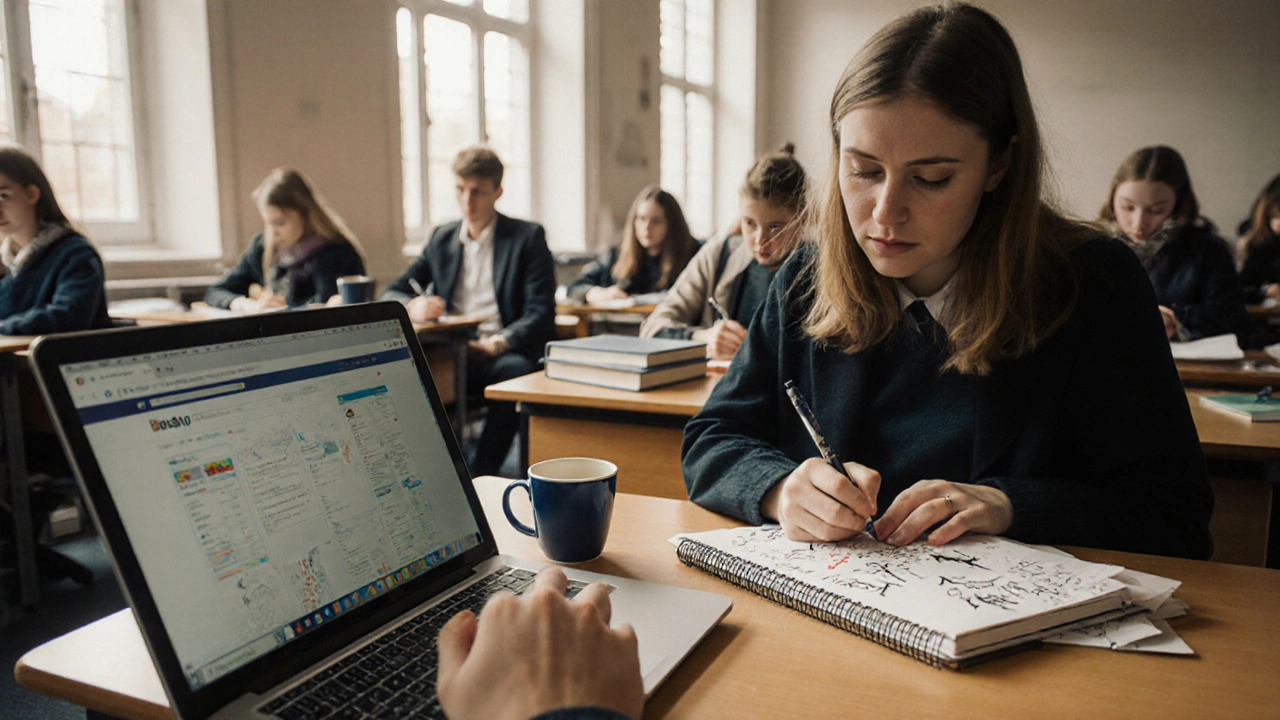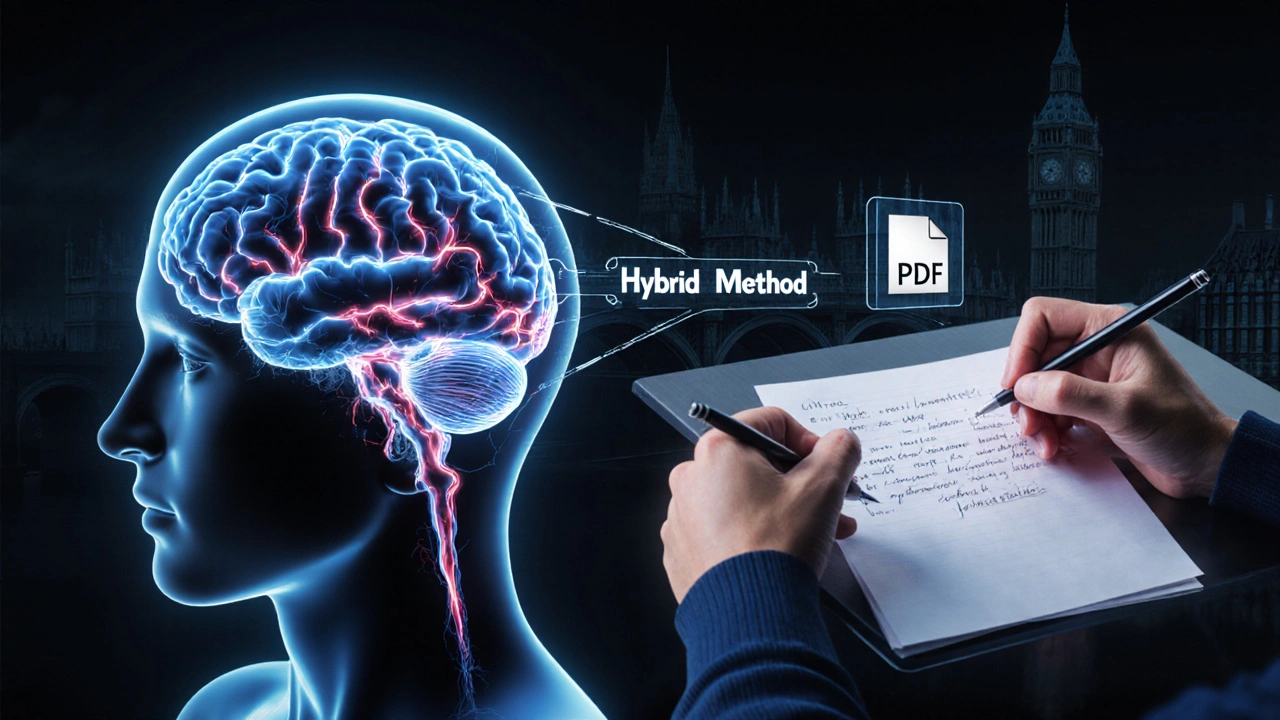
Every year, thousands of UK students walk into lectures with laptops open, ready to type everything the professor says. Others sit beside them, pens in hand, scribbling slowly, carefully, word by word. Both think they’re doing the right thing. But only one method actually helps them remember more, understand deeper, and perform better in exams. The truth? It’s not about speed. It’s about how your brain processes information.
Why Typing Feels Better-But Isn’t
Laptops are fast. You can type 60 to 80 words per minute. Handwriting? Maybe 20 to 30. In a fast-paced lecture, typing feels like you’re keeping up. You capture every detail. You don’t miss a single statistic or date. It looks efficient. But here’s the catch: when you type everything, you’re not thinking-you’re transcribing.A 2014 study by Princeton and UCLA tracked over 100 students across two universities. Those who took notes on laptops scored worse on conceptual questions than those who wrote by hand-even though they had more words on their screen. Why? Because typing encourages mindless copying. Your brain stops filtering. It stops summarizing. It stops connecting ideas.
Handwriting forces you to slow down. You can’t write every word. So you pick the important ones. You rephrase. You draw arrows. You write ‘vs.’ between two theories. That act of selection? That’s learning.
How Handwriting Changes Your Brain
When you write by hand, your brain activates regions tied to memory and understanding. The motor cortex, the visual cortex, and the hippocampus all work together. This isn’t just a metaphor. Neuroscientists have seen real, measurable differences in brain activity.One fMRI study showed that students who took handwritten notes had stronger activation in areas linked to language processing and idea integration. Typing, on the other hand, lit up mostly the motor areas-like your fingers were doing a dance, but your mind was on autopilot.
Think of it this way: if you’re copying a recipe word-for-word from your phone, you’ll follow it. But if you write it out by hand, you remember the ingredients, the steps, even the smell of the herbs. That’s because writing creates a mental imprint.
What UK Students Are Actually Doing
A 2023 survey of 1,200 university students across England, Scotland, and Wales found that 73% used laptops for note-taking in lectures. But only 29% said they ever reviewed those notes beyond the week before an exam. Meanwhile, 61% of students who wrote by hand said they reread and revised their notes regularly.Why the difference? Handwritten notes are messy. They’re personal. They have doodles, underlines, stars, and question marks. That messiness makes them memorable. Digital notes? Clean, neat, and boring. They look like a transcript. You don’t want to open them again.
And let’s not forget distractions. A UK student survey from the University of Edinburgh found that 82% of laptop users admitted to checking social media or emails during lectures. Only 11% of handwriting students reported the same. Your phone isn’t the problem-it’s the open browser tab.

When Laptops Actually Help
Handwriting isn’t magic. There are times when typing wins.If you’re in a science or engineering lecture with equations, formulas, or code snippets, typing is faster and more accurate. Trying to draw a chemical structure by hand? Good luck. Typing out Python syntax? Much easier.
Students with dyslexia, ADHD, or motor impairments also benefit from digital tools. Speech-to-text software, spell-check, and easy editing make learning accessible. For these learners, laptops aren’t a distraction-they’re a lifeline.
And if you’re reviewing material later, digital notes are easier to search. You can Ctrl+F for “Kant” or “supply chain model.” Handwritten notes? You’ll need to flip through pages. But here’s the trick: scan your handwritten notes into a PDF and use OCR software. Now you get the best of both worlds-deep processing during class, and quick searchability later.
The Hybrid Approach That Works
The best note-takers don’t choose one method. They combine them.Here’s what works for top-performing UK students:
- Take handwritten notes during lectures. Use abbreviations, symbols, and diagrams.
- Within 24 hours, type up a clean version. Don’t copy word-for-word. Summarize. Connect ideas.
- Add your own questions: “Why does this matter?” “How is this different from last week?”
- Use digital tools only for revision: flashcards, mind maps, or audio recordings of your summary.
This method was tested by the University of Manchester in a 12-week trial with 150 undergraduates. Students using the hybrid approach scored 18% higher on final exams than those who stuck to one method. They also reported less stress during revision.

What to Avoid
Don’t fall into these traps:- Don’t record lectures and expect to listen later. You’ll never get around to it.
- Don’t use pre-made slide notes. They’re someone else’s thinking-not yours.
- Don’t multitask. If you’re typing, close everything but your notes app.
- Don’t assume more words = better learning. Quality beats quantity every time.
Practical Tips for UK Students
If you’re trying to improve your notes, start here:- Try the Cornell Method by hand. Divide your page into three sections: cues, notes, summary.
- Use a cheap spiral notebook. No need for fancy journals. Just something you won’t feel guilty scribbling in.
- Keep a pen and paper in your bag-even if you use a laptop. Sometimes, the best idea comes when you’re stuck.
- At the end of each lecture, write one sentence: “The big idea today was…”
- Review your notes out loud. Saying them helps your brain lock them in.
Some students swear by specific pens-like the Pilot G-2 0.7mm or the Uni-ball Signo 207. Others use different colored pencils for themes: blue for definitions, red for examples, green for questions. It sounds silly. But if it helps you remember, it’s worth it.
Final Thought: It’s Not About Tools. It’s About Thinking.
The question isn’t “laptop or pen?” It’s “are you thinking while you take notes?”Handwriting isn’t better because it’s old-school. It’s better because it slows you down enough to think. Typing isn’t worse because it’s digital. It’s worse when you use it to avoid thinking.
UK students aren’t failing because they use laptops. They’re failing when they let their laptops do the thinking for them.
The best notes aren’t the ones with the most words. They’re the ones that make you say, ‘Ah, I get it now.’
Is handwriting better than typing for exams?
Yes, for most students, handwriting leads to better exam results because it forces deeper processing. Studies show students who write notes by hand remember concepts longer and perform better on questions that require understanding, not just recall. But if you type and then rewrite your notes in your own words within 24 hours, you can close the gap.
Can I use a tablet with a stylus instead of pen and paper?
Yes. A tablet with a stylus, like an iPad with Apple Pencil or a Samsung Galaxy Note with S Pen, behaves much like handwriting. The key is avoiding keyboard shortcuts and typing. If you’re drawing, sketching, and writing in cursive or print, your brain gets the same benefits as with paper. Just make sure you’re not switching to typing during the lecture.
Should I take notes if I’m not a fast writer?
Absolutely. Speed isn’t the goal. Focus is. Even if you only catch 60% of what’s said, the act of selecting what’s important helps your brain learn. You can always fill in gaps later using lecture slides, recordings, or classmate notes. The important part is that your notes reflect your understanding-not a transcript.
Do I need to throw away my laptop for note-taking?
No. Laptops are useful for typing equations, code, or long quotes. But use them for editing and reviewing-not for live note-taking. Try this: take handwritten notes in class, then type a summary at home. That way, you get the brain benefits of writing and the convenience of digital storage.
What if my university requires digital notes?
Many universities don’t require digital notes-they just assume students use laptops. If you prefer handwriting, bring a notebook. If you’re asked to submit notes, scan them into a PDF. Most institutions accept scanned handwritten notes as long as they’re legible. The goal is learning, not format.